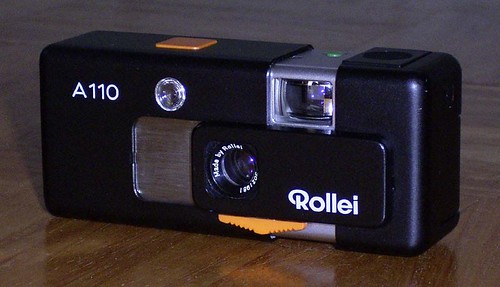
|
| black magic pocket camera made by Rollei |
When the Rollei A 110 (or A110) appeared on the market it was advertised as the world's smallest pocket camera. Utilizing the new pocket film standard of the 1970s, the 110 film cartridge, it was the smallest serious camera yet introduced to the market. Heinz Waaske's camera construction team needed 2 years from construction to mass production. In 1974 the prototype of the A 110 was a sensation at the camera fair "Photokina" since it was smaller than the cardboard boxes in which the single pocket films were sold. But mass production was delayed until late 1975. The efforts needed to make that miniature camera consisting of 260 parts in a good quality were time consuming. The camera entered the market high-priced. 1978, before its production was moved from Braunschweig to Singapore, it had already reached a lower price level, 348 DM.
The camera has a typical 110 film camera design: it has to be pulled open. When it is closed important parts like the lens and viewfinder are covered by the two outer parts of the camera body, so this pocket camera can really be carried in the pocket. The difference to the average pocket camera is the use of mainly metal parts for its construction. Most of the few plastic parts are made of the durable [[1]]. This choice of quality materials was necessary for reaching the high level of miniaturization and quality.
A true innovation was the camera's exposure system. The shutter blades are open and the aperture blades are shut before exposure begins. The actual exposure begins with the opening of the aperture blades to the programmed f/stop (f/2.8-f/16), and ends with closing of the shutter blades. Exposure control is also different: the silicon-photo-diode has its own aperture blades whose opening varies as those in the lens. Both apertures are driven by the same mechanical element. Between the aperture opening and shutter closing the lens's aperture blades are kept in position by an electromagnet. Advancing the film (i.e. closing and opening the camera) resets the aperture and shutter to their original positions.
Despite its short focal length, the lens focuses from infinity to 1 meter via the orange focusing slide on the camera's front (below the lens). A distance scale with a combination of meter/feet figures and symbols is displayed in the viewfinder.
In the right hands and with suitable film such as Verichrome Pan, the Rollei A 110 was capable of making very good 5x7 prints and even passable 8x10s.
specifications
- Type: pocket camera
- Manufacturer: Rollei (1975-1978 in Braunschweig (124.000 units), 1978-1981 in Singapore (72.000 units))
- Year of launch: 1974
- Film: Type No. 110 cartridges for 16mm film with speeds 64 to 500 ASA
- Lens: Rollei Tessar 1:2.8/23mm
- Shutter: electronically controlled Rollei-Prontor leaf shutter
- Exposure: fast silicium photo diode measures light for program-controlled exposure with shutter-speed/aperture combinations from 1:2.8 - 4sec. to 1:16 - 1/400 sec.
- Dimensions: 84×44×30mm (closed, length 100 mm when opened)
- Weight: 185 g with battery